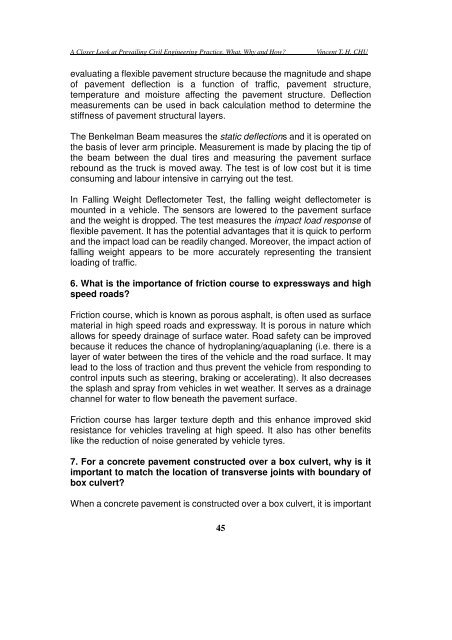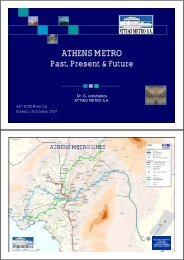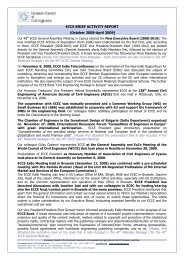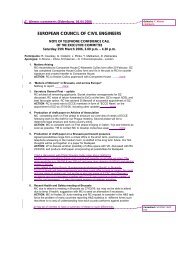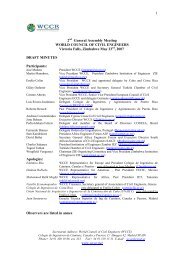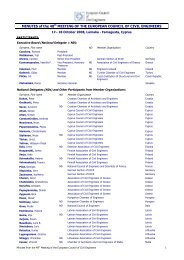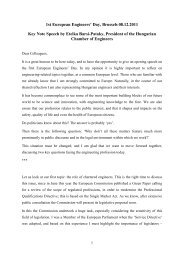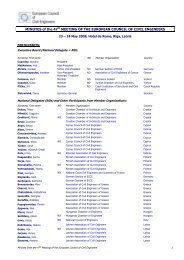A Closer Look at Prevailing Civil Engineering Practice - European ...
A Closer Look at Prevailing Civil Engineering Practice - European ...
A Closer Look at Prevailing Civil Engineering Practice - European ...
You also want an ePaper? Increase the reach of your titles
YUMPU automatically turns print PDFs into web optimized ePapers that Google loves.
A <strong>Closer</strong> <strong>Look</strong> <strong>at</strong> <strong>Prevailing</strong> <strong>Civil</strong> <strong>Engineering</strong> <strong>Practice</strong>, Wh<strong>at</strong>, Why and How<br />
Vincent T. H. CHU<br />
evalu<strong>at</strong>ing a flexible pavement structure because the magnitude and shape<br />
of pavement deflection is a function of traffic, pavement structure,<br />
temper<strong>at</strong>ure and moisture affecting the pavement structure. Deflection<br />
measurements can be used in back calcul<strong>at</strong>ion method to determine the<br />
stiffness of pavement structural layers.<br />
The Benkelman Beam measures the st<strong>at</strong>ic deflections and it is oper<strong>at</strong>ed on<br />
the basis of lever arm principle. Measurement is made by placing the tip of<br />
the beam between the dual tires and measuring the pavement surface<br />
rebound as the truck is moved away. The test is of low cost but it is time<br />
consuming and labour intensive in carrying out the test.<br />
In Falling Weight Deflectometer Test, the falling weight deflectometer is<br />
mounted in a vehicle. The sensors are lowered to the pavement surface<br />
and the weight is dropped. The test measures the impact load response of<br />
flexible pavement. It has the potential advantages th<strong>at</strong> it is quick to perform<br />
and the impact load can be readily changed. Moreover, the impact action of<br />
falling weight appears to be more accur<strong>at</strong>ely representing the transient<br />
loading of traffic.<br />
6. Wh<strong>at</strong> is the importance of friction course to expressways and high<br />
speed roads<br />
Friction course, which is known as porous asphalt, is often used as surface<br />
m<strong>at</strong>erial in high speed roads and expressway. It is porous in n<strong>at</strong>ure which<br />
allows for speedy drainage of surface w<strong>at</strong>er. Road safety can be improved<br />
because it reduces the chance of hydroplaning/aquaplaning (i.e. there is a<br />
layer of w<strong>at</strong>er between the tires of the vehicle and the road surface. It may<br />
lead to the loss of traction and thus prevent the vehicle from responding to<br />
control inputs such as steering, braking or acceler<strong>at</strong>ing). It also decreases<br />
the splash and spray from vehicles in wet we<strong>at</strong>her. It serves as a drainage<br />
channel for w<strong>at</strong>er to flow bene<strong>at</strong>h the pavement surface.<br />
Friction course has larger texture depth and this enhance improved skid<br />
resistance for vehicles traveling <strong>at</strong> high speed. It also has other benefits<br />
like the reduction of noise gener<strong>at</strong>ed by vehicle tyres.<br />
7. For a concrete pavement constructed over a box culvert, why is it<br />
important to m<strong>at</strong>ch the loc<strong>at</strong>ion of transverse joints with boundary of<br />
box culvert<br />
When a concrete pavement is constructed over a box culvert, it is important<br />
45


